Haunted Heritage – Warstone Lane Cemetery
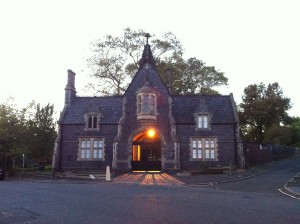 Warstone Lane cemetery in the Jewellery quarter dates from 1847, and is Grade II listed on the Register of Parks and Gardens of special Historic interest.
Warstone Lane cemetery in the Jewellery quarter dates from 1847, and is Grade II listed on the Register of Parks and Gardens of special Historic interest.
One of it’s main features is the 2 tiers of catacombs, which were required by the ‘Birmingham cemeteries act’ of 1846 to be sealed with lead or pitch due to the unhealthy vapours and unpleasant smell emanating from them! These catacombs are home to John Baskerville, creator of the ‘Baskerville Typeface’.
This unfortunate soul’s corpse had a fair way to travel before reaching his final resting place in Warstone Lane Cemetery. John Baskerville was very successful in the Japanning Trade, which was the application of lacquer to buttons, snuff-boxes and candlesticks etc. Before he made his fortune in the Japanning trade, he was well known for the beautiful calligraphy and typography he used to inscribe tombstones and memorials. Here it is supposed, is where the groundings of his now famous ‘Baskerville Typeface’ began. He fell on hard times after attempting to publish a series of unpopular books, and retreated to his mansion ‘Easy Hill’. (Now known as Baskerville House.) He died in January of 1775, and his will required that he be buried vertically in a vault on his own property. Unfortunately, that is not where he remained. When his wife Sarah died in 1788, Easy Hill was sold, and after a complicated series of events, it was taken for canal wharfs and buildings. After repeated excavations by the canal builders, Baskerville’s body was found beneath a pile of gravel. It was incredibly well preserved given that it had spent 46 years underground, and this was attributed to the air-tight lead lined coffin.
Because of Baskerville’s outspoken atheism, he was refused burial in the local cemetery, and the coffin spent the next 8 years in canal builder Thomas Gibson’s warehouse in Cambridge street. Gibson exhibited the body for sixpence a head, and one of those curious visitors, a Thomas Underwood, sketched the body on August 15th, 1829.
A local newspaper dated May 1821 wrote-
his body was, after forty-six years underground, in a singular state of preservation. It was wrapped in a white linen shroud with a branch of laurel, faded but firm in texture. The skin on the face was dry but perfect. The eyes were gone, but eye brows, the eye lashes, lips and teeth remained. The skin on the abdomen and body generally was in the same state with the face. An unpleasant smell strongly resembling decayed cheese arose from the body, and rendered it necessary to close the coffin quickly.”
After this, the body was moved to plumber and glazier John Marston’s shop, where it was re-opened to the public. This was disastrous for the cadaver, and many who viewed it were overcome by “the effluvium” or unpleasant odour, and so the body was moved again into the Baskerville family vaults in Christ Church. When these were cleared in 1890 in order to demolish the building, the body was moved one final time and re-interred in the vaults beneath the chapel at Warstone Lane. This chapel no longer stands (it was demolished in 1954), but Baskerville remains in the catacombs of the cemetery.
In terms of ghosts, a woman dressed in 1930’s attire has been seen many times, and has shocked onlookers by walking through walls and parked cars, even causing a moving car to screech to a halt only to smile at the driver and promptly disappear. Accompanying sightings of this lady, people claim to have noticed a smell of pear drops, which is what Arsenic is said to smell like after it has been swallowed. This dangerous substance was used in the jewellery quarter at one time, which leads us to believe that this lady was killed by arsenic poisoning.
Another witness claims to have spoken to a young man in an army style trench coat near the catacombs. During conversation, the young man referred to the Dudley Road Hospital as “The Infirmary”, a name not used for the hospital since 1948. When the witness walked away and turned to look again at the young man, he had disappeared.
Given that many times in Warstone’s history bodies were dug up and re-buried, it is little wonder the area is haunted. It was known in the early 18th century as ‘Dead Mans Lane’ and it is possible that at some point a Gallows would have been situated nearby. These were traditionally placed at cross-roads as they allowed un-consecrated burials, and one such cross road exists where the lane meets Icknield Street.
Warstone Lane and Keyhill cemeteries are haunting and lovely especially at dusk which is when we visited, but many websites also warn that the area can be quite dangerous after dark. With this in mind, it is advised to see them during daylight hours. We didn’t see a soul, (excuse the pun) but as the light faded, our imaginations did get the better of us and we made our trip brief lest we should witness sinister activity be it of the living or of the dead! Definitely worth a visit if you are in the area.


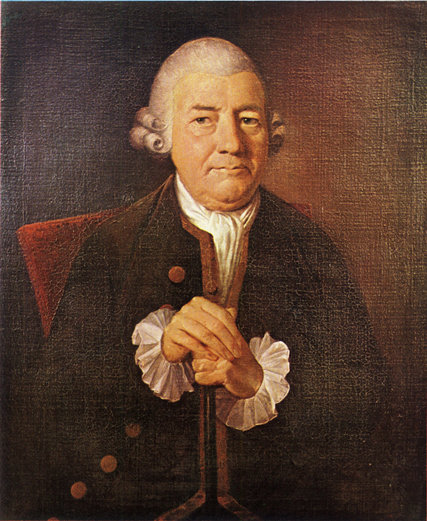
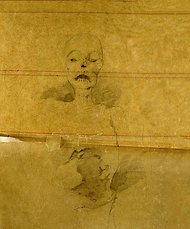
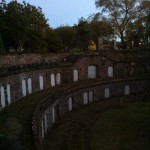
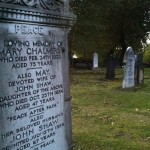
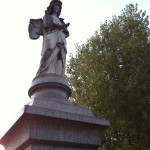

I will take your advice Sarah! Interesting insight into burial practices for non-believers. We need to know more about this attitude towards death for our interpretion of the Coffin Fitting works.